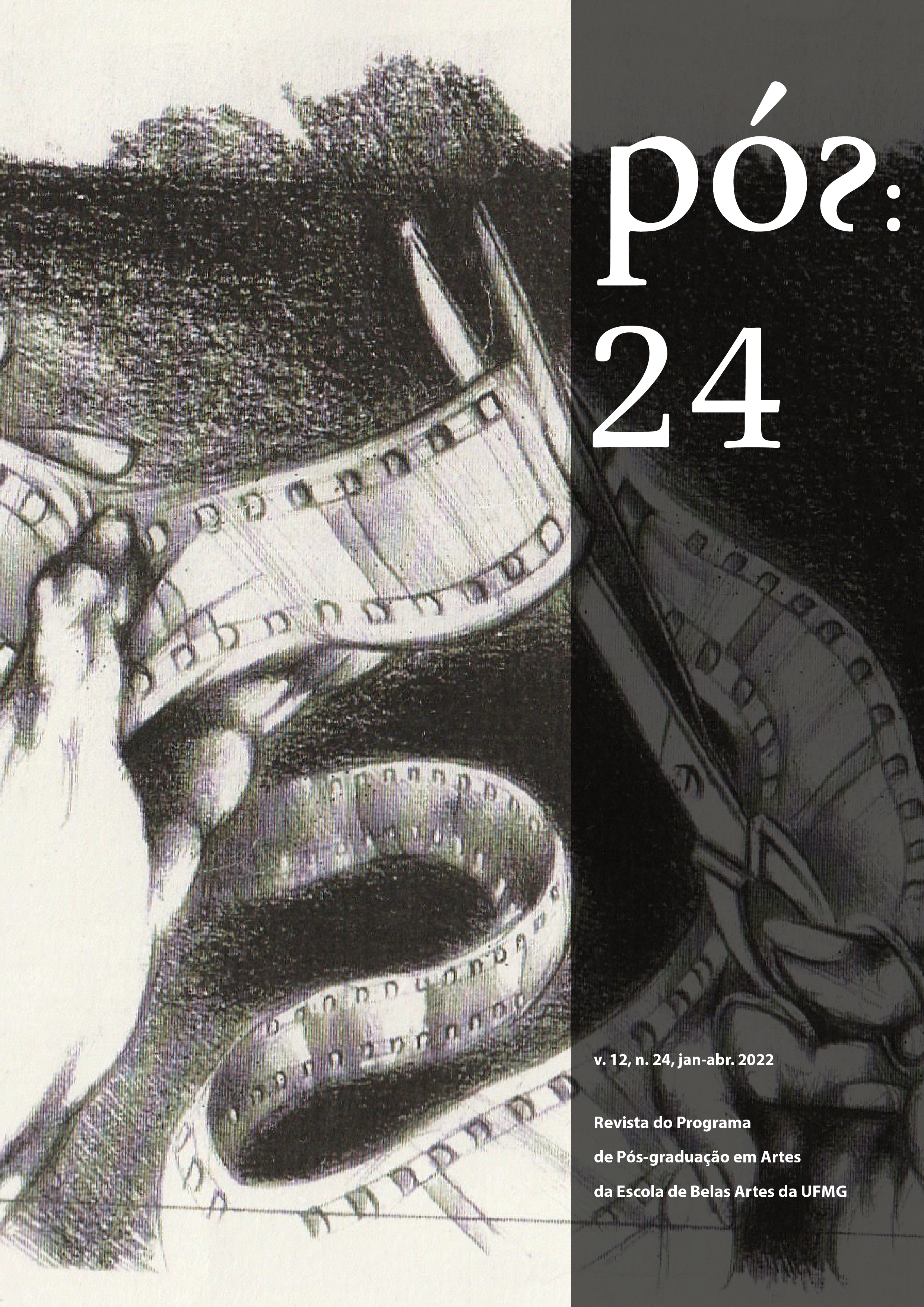English Allegory of terror
resignifying Trilogy of terror (1968)
DOI:
https://doi.org/10.35699/2237-5864.2022.35730Keywords:
Brazilian cinema, Horror cinema, AllegoryAbstract
This article proposes an analysis of Trilogy of terror, a Brazilian horror anthology film released in 1968. The movie has three independent stories linked to the universe of genre cinema and directed by São Paulo filmmakers who were beginning to become popular among audiences and critics: Ozualdo Candeias, Luis Sérgio Person and José Mojica Marins. The first two chose to use horror elements to create allegories that represented Brazilian society at the time – in years of Military Dictatorship and strong behavioral changes. The result is a very unique cinematic experience.
Downloads
References
BARCINSKI, André; FINOTTI, Ivan. Maldito: A vida e o cinema de José Mojica Marins. São Paulo: Editora 34, 1998.
BLANCO, Armindo. Filme o seu monstro e fature os bilhões. O Globo, Rio de Janeiro, 26 abr. 1968. Disponível em:<http://www.memoriacinebr.com.br/pdfsNovos/9990350I00401.pdf>. Acesso em: 20 jan. 2020.
CAETANO, Daniel. O Acordo. Contracampo, 2006. Disponível em: <http://www.contracampo.com.br/25/oacordo.htm>. Acesso em: 10 set. 2010.
CANDEIAS, Ozualdo Ribeiro. Entrevista com Candeias. [Entrevista concedida a] Filme Cultura, Rio de Janeiro, 20 jul. 1968, p. 23-27.
CÁNEPA, Laura Loguercio. O Saci e procissão dos mortos: auto-referência fantástica no cinema paulista. Rumores, São Paulo, v. 1, n. 6, set. 2009. Disponível em:<https://www.revistas.usp.br/Rumores/article/view/51165/55235>. Acesso em: 20 jan. 2020.
CARDENUTO, Reinaldo. Trilogia de Terror. Portal Brasileiro de Cinema, 2005. Disponível em:<http://www.portalbrasileirodecinema.com.br/mojica/filmes/03_06.php> Acesso em:20 jan. 2020.
CASCUDO, Luís da Câmara. Meleagro: pesquisa do Catimbó e notas da magia branca no Brasil. Rio de Janeiro: Livraria Agir, 1978.
CEIA, Carlos. Sobre o conceito de alegoria. Matraga, Rio de Janeiro, v. 1, n. 10, ago. 1998. Disponívelem: <http://www.pgletras.uerj.br/matraga/matraga10/matraga10a02.pdf>. Acesso em: 15 ago. 2020.
DE PAIVA, Salvyano Cavalcanti. Cinema. Correio da Manhã, Rio de Janeiro, ano 67, n. 23.018, 21 abr.1968b. Segundo Caderno, p. B3.
DE PAIVA, Salvyano Cavalcanti. Crítica de “Trilogia de Terror” – Parte 1. Correio da Manhã, Rio de Janeiro, ano 67, n. 23.019, 23 abr. 1968c. Segundo Caderno, p. B3.
DE PAIVA, Salvyano Cavalcanti. Crítica de “Trilogia de Terror” – Parte 2. Correio da Manhã, Rio de Janeiro, ano 67, n. 23.020, 24 abr. 1968d. Segundo Caderno, p. B3.
DE PAIVA, Salvyano Cavalcanti. Crítica de “Trilogia de Terror” – Parte 3. Correio da Manhã, Rio de Janeiro, ano 67, n. 23.021, 25 abr. 1968e. Segundo Caderno, p. B3.
DE PAIVA, Salvyano Cavalcanti. De produtores e produções. Correio da Manhã, Rio de Janeiro, ano 67, n. 22.980, 6 mar. 1968a. Segundo Caderno, p. B3.
FONSECA, Carlos. Candeias: na estrada do cinema. Filme Cultura, Rio de Janeiro, n. 10, 20 jul. 1968, p. 20-27.
GARDNIER, Ruy. O que há para saber sobre Ozualdo Candeias? Contracampo, 2006. Disponível em:<http://www.contracampo.com.br/25/sabersobreozualdo.htm>Acesso em: 10 set. 2010.
GRANT, Barry Keith. Film genre: From iconography to ideology. New York: Wallflower Press, 2007.
INDICAÇÕES: Cinema. Realidade, São Paulo, n. 27, jun. 1968, p. 23.
MENEZES, Carlos Lúcio. Parecer da Censura sobre “Trilogia de Terror”. Brasília, 9 abr. 1968. Disponívelem:<http://www.memoriacinebr.com.br/pdfsNovos/9990350C00402.pdf>. Acesso em: 20 jan. 2010.
MONTEIRO, José Carlos. “Trilogia de Terror”, Fantástico grau zero. Tribuna da Imprensa, Rio de Janeiro, ano 19, n. 5.555, 26 abr. 1968, p. 7.
N.H.S. Crítica de “Trilogia de Terror”. O Jornal, Rio de Janeiro, ano 48, n. 14.293, 4 maio 1968. Segundo Caderno, p. 3.
RODRIGUES, Jaime. “A Margem”, um filme admirável. Correio da Manhã, Rio de Janeiro, ano 67, n. 22.977, 2 mar. 1968. Segundo Caderno, p. B1.
SHARRETT, Christopher. The horror film as social allegory (and how it comes undone). In: BENSHOFF, Harry M. (ed.). A companion to the horror film. West Sussex: Wiley-Blackwell, 2014. p. 56-72.
TELES, Ângela Aparecida. Uma estética da precariedade: Migrações e trocas interculturais no cinema de Ozualdo Candeias (1967-1992). Dossiê: História e Cultura Visual, São Paulo, v. 26, n. 2, p. 161-181, 2007. Disponível em:<https://www.scielo.br/j/his/a/WBbBky5jdn36Wq93NCdS85H/?lang=pt> Acesso em: 10 jan. 2010.
TRILOGIA de Morfeu. Correio da Manhã, Rio de Janeiro, ano 67, n. 23.020, 25 abr. 1968. Segundo Caderno, p. B2.
XAVIER, Ismail. A alegoria histórica. In: RAMOS, Fernão Pessoa (org.). Teoria contemporânea do cinema. São Paulo: Senac, 2005. v. 1.p. 339-379.
Downloads
Published
Issue
Section
License
Copyright (c) 2022 Felipe do Monte Guerra, Carlos Gerbase

This work is licensed under a Creative Commons Attribution-NonCommercial 4.0 International License.
Authors who publish in this journal agree to the following terms:
- Authors retain copyright and grant the journal the right of first publication, with the work simultaneously licensed under the a Creative Commons Attribution-NonCommercial 4.0 International License that permits sharing of the work with acknowledgement of authorship and initial publication in this journal;
- Authors are permitted to enter into additional contracts separately, for non-exclusive distribution of the version of the work published in this journal (e.g., the Creative Commons Attribution License).
- Authors are permitted and encouraged to publish and distribute their work online (e.g., in institutional repositories or on their home page) at any point before or during the editorial process, as this may generate productive changes as well as increase the impact and citation of the published work.
- It is the responsibility of the authors to obtain written permission to use in their articles materials protected by copyright law. Revista PÓS is not responsible for copyright breaches made by its contributors.












